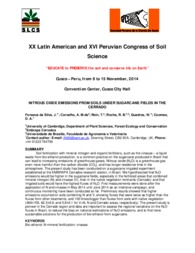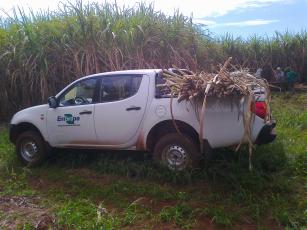Nitrous oxide emissions from soils under sugarcane fields in the Cerrado.
Nitrous oxide emissions from soils under sugarcane fields in the Cerrado.
Autoria: FONSECA DA SILVA, J.; CARVALHO, A. M. de; REIN, T. A.; ROCHA, R. B.; RIBEIRO JUNIOR, W. Q.; COOMES, D. A.
Resumo: Soil fertilization with mineral nitrogen and organic fertilizers, such as the vinasse ? a liquid waste from bio-ethanol production, is a common practice on the sugarcane produced in Brazil that can lead to increasing emissions of greenhouse gases. Nitrous oxide (N2O) is a greenhouse gas even more harmful than the carbon dioxide (CO2), and has longer residence time in the atmosphere. The present study has been conducted on a sugarcane irrigated experiment established at the EMBRAPA Cerrados research station, in Brazil. We hypothesized that N2O emissions would be higher in the sugarcane fields, especially in the fertilized areas that combined mineral nitrogen (N) and vinasse (V), than in the native vegetation remnants (Cerrado); and that irrigated soils would have the highest fluxes of N2O. First measurements were done after the application of N and vinasse in May 2014 until June 2014 as an intensive campaign, and continuous monitoring have been conducted so far. Preliminary results showed that higher emissions occurred on soils combining N and V, showing fluxes that were twice as higher than the fluxes from other treatments, and 100 times bigger than fluxes from soils with native vegetation (469±158, 62.3±6.9, and 0.8±0.1 for V+N, N and Cerrado areas, respectively). The present study is pioneer in the Cerrado region and data are important to assess the regional variations on the N2O fluxes in Brazil, to reduce the bias on national estimations of N2O emissions, and to find more sustainable solutions for the production of bio-ethanol from sugarcane.
Ano de publicação: 2014
Tipo de publicação: Artigo em anais e proceedings
Unidade: Embrapa Cerrados
Palavras-chave: Biocombustível, Bioethanol, Brazil, Cana de açúcar, Cerrado, Emissão de gás, Fertilizante nitrogenado, Gas emissions, Nitrogen fertilisers, Nitrogen oxides, Savannas, Soil, Solo, Sugarcane, Vinasse, Vinhaça, Óxido nitroso
Conteúdo relacionado
Observações
1 - Por padrão são exibidas publicações dos últimos 20 anos. Para encontrar publicações mais antigas, configure o filtro ano de publicação, colocando o ano a partir do qual você deseja encontrar publicações. O filtro está na coluna da esquerda na busca acima.
2 - Para ler algumas publicações da Embrapa (apenas as que estão em formato ePub), é necessário ter, no celular ou computador, um desses softwares gratuitos. Sistemas Android: Google Play Livros; IOS: iBooks; Windows e Linux: software Calibre.
Acesse outras publicações
Acesse a Base de Dados da Pesquisa Agropecuária (BDPA) para consultar o acervo completo das bibliotecas da Embrapa.


